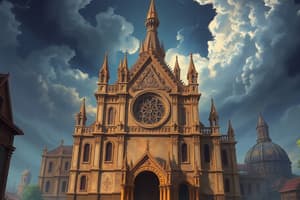Podcast
Questions and Answers
¿Cuál era la base de la autoridad de la Iglesia Católica en la Edad Media?
¿Cuál era la base de la autoridad de la Iglesia Católica en la Edad Media?
- Su reclamo de ser la guardiana de la verdad divina y la intérprete de la voluntad de Dios (correct)
- Su capacidad militar y poderío
- Su riqueza y poder económico
- Su influencia en la política y la cultura
¿Cuál era el papel del Papa en la Edad Media?
¿Cuál era el papel del Papa en la Edad Media?
- Era el jefe del ejército cristiano
- Era un mero administrador de propiedades eclesiásticas
- Era el supremo autoridad espiritual, con el poder de nombrar obispos y otorgar indulgencias (correct)
- Era un simple consejero del rey
¿Cuál fue el resultado de la Querella de las Investiduras?
¿Cuál fue el resultado de la Querella de las Investiduras?
- Se estableció una monarquía absoluta en Europa
- La Iglesia perdió influencia y poder
- Se produjo una gran guerra en Europa occidental
- La Iglesia emergió victoriosa, estableciendo su supremacía en asuntos espirituales (correct)
¿Cuál fue el objetivo de las Cruzadas?
¿Cuál fue el objetivo de las Cruzadas?
¿Qué reformas buscaban fortalecer la autoridad papal?
¿Qué reformas buscaban fortalecer la autoridad papal?
¿Cuál era la fuente de ingresos más importante de la Iglesia?
¿Cuál era la fuente de ingresos más importante de la Iglesia?
Flashcards are hidden until you start studying
Study Notes
Catholic Church Power in the Middle Ages
Authority and Influence
- The Catholic Church was the dominant authority in medieval Europe, wielding significant spiritual, political, and economic power.
- The Church's authority was based on its claim to be the guardian of divine truth and the interpreter of God's will.
Papal Power
- The Pope was considered the supreme spiritual authority, with the power to appoint bishops, grant indulgences, and excommunicate individuals.
- The Papal States, a territory in central Italy, was under the direct control of the Pope, providing a significant source of revenue and influence.
Cluniac Reforms
- The Cluniac Reforms (10th-12th centuries) aimed to purify the Church, promoting a stricter adherence to monastic rules and greater papal authority.
- The reforms strengthened the Church's control over secular rulers, solidifying its position as a powerful institution.
Investiture Controversy
- The Investiture Controversy (11th-12th centuries) was a power struggle between the Church and secular rulers over the right to appoint bishops and abbots.
- The Church emerged victorious, establishing its supremacy in spiritual matters and limiting the power of secular rulers.
Crusades and Military Power
- The Church sanctioned and encouraged military campaigns, such as the Crusades, to reclaim the Holy Land and spread Christianity.
- The Church's military power was significant, with the Knights Templar and other military orders playing a crucial role in defending Christian territories.
Economic Power
- The Church controlled vast tracts of land, generating significant revenue through tithes, taxes, and rents.
- The Church's economic power allowed it to finance grand architectural projects, such as cathedrals and monasteries.
Social Influence
- The Church played a central role in shaping medieval society, influencing art, literature, and education.
- The Church's teachings on morality, sin, and salvation shaped the worldview of medieval Europeans.
Studying That Suits You
Use AI to generate personalized quizzes and flashcards to suit your learning preferences.




